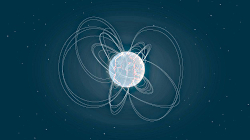 HEAPOW: A Loud Cry from a Baby Magnetar (2021 Jun 14)
HEAPOW: A Loud Cry from a Baby Magnetar (2021 Jun 14)
The strongest magnets in the universe are magnetars, the crushed remnants of massive stars that are left behind after the nuclear fuel which sustains them is all used up, causing the center of the star to collapse to extremely high densities (about the same as the density of the atomic nuclei in your body) while (nearly simultaneously) the rest of the star explodes outwards as a supernova. Although massive stars usually have very weak magnetic fields, during the compactification of the core the magnetic field becomes intensified, reaching about one trillion times stronger than the magnetic field at the surface of the earth. Magnetars are extreme types of neutron stars, but have magnetic fields which are about 1000 times the strength of the magnetic field of a typical neutron star, and are typically only detected from their X-ray and gamma-ray emission (while typical neutron stars are usually strong radio emitters). Just a few dozen magnetars are known. The image above shows an artist's conception of the surface of a magnetar, based on the best science available. The image shows the surface of the magnetar, almost perfectly spherical, and the complicated tentacles of the magnetar's magnetic field reaching out into space. Like neutron stars, magnetars rotate, but typically at a much slower rate than the typical neutron star. In early 2020 NASA'S Swift observatory detected a burst of high energy emission from a previously unknown source, powerful enough to outshine a half-million Suns. Followup observations of this source by Swift, and by the XMM-Newton X-ray observatory, the NuSTAR hard X-ray observatory, and radio observations using the Sardinia Radio Telescope revealed this object is astonishingly young magnetar, only about 240 years old, the youngest magnetar yet discovers. The magnetar lies at a distance of about 16,000 lightyears from earth, so the magnetar's activity actually happened about 16,000 years ago. Oddly, the magnetar also showed unusually bright, periodic radio emission. These observations suggest that this object may be an unusual link between older neutron stars (which shine from conversion of rotational energy to radiation) and young magnetars (which shine due to conversion of magnetic energy to radiation).
ESA: XMM-Newton Spies Youngest Baby Pulsar Ever Discovered
JPL: A Cosmic Baby is Discovered, and It's Brilliant
viewtopic.php?t=40688
| << Previous HEAPOW | High Energy Astrophysics Picture of the Week | Next HEAPOW >> |